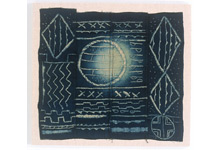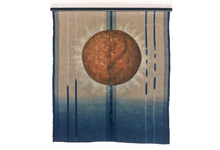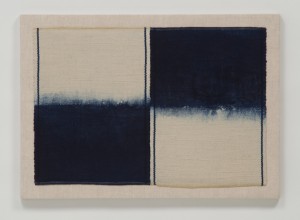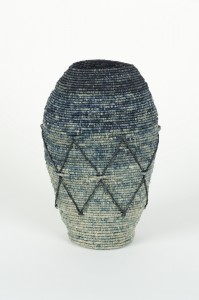I teach a workshop called Sources of Inspiration. It is specifically geared to fiber artists, but has been enjoyed by artists from other media as well. I talk about the three things that, in my experience, stimulate us to creativity.
For most beginning weavers, it is the materials that grab our attention. The threads themselves are so seductive whether lustrous, brilliantly colored or subtly natural. And so we start out with the prettiest yarns we can find and often discover that when one half is covered by another thread in tabby, we end up with a product that is completely different than what we expected. As we practice more and add woven structures like notches on our belt, as we learn to dye and full and finish a cloth and the various techniques of surface design, we garner the self-confidence that comes with the mastery of technique.
Technique itself becomes our second source of inspiration. As our hands become adept our artistic voice refines itself as well.

Ndop, handwoven silk with shibori surface design by Barbara Shapiro
When finally at some point we are able to express ourselves, give voice to our feelings and personal history, concept becomes prominent. Now this does not mean that all mature work has to shout out a message, no bra burning imagery is necessary for a work to convey deeply felt emotion. Beauty created by the human hand can itself be an uplifting concept. The ability to express emotion with materials and technique is what matters to me. This is what makes a textile a work of art.

Above an Indigo Sea by Barbara Shapiro
My workshop students do several hands on exercises designed to put them in touch with what inspires them personally. We all work differently, but knowing what you like instinctively and thinking about why these things attract you, can bring better understanding of the artist within. My students consider what stories from their past make certain types of imagery, colors, or pattern appealing. Finally my students do exercises to build on this understanding with the goal of imagining a new body of work that will resonate with what they really want to say.
I will be teaching this workshop along with some creatively versatile basketry techniques at the San Luis Obispo Art Museum this July.
For my own textile art practice, I do keep notes of projects I may want to take on, going through them from time to time and discarding or editing until one day I move from thought to practice. I usually work in series and one project often suggests the next.

Foursquare, handwoven linen and cotton, indigo shibori dyed by Barbara Shapiro
The question “What if?” popped up as I slowly coiled yet another indigo disk for a recent exhibit. I few months later I found myself incorporating bits of colored fabric collected from friends around the world as these disks took on references to the universality of indigo and the importance of friendship.
Guild meetings, museums, galleries, and the many journals and books I read keep ideas flowing, even if I do not often create the work envisioned in the small sketch of a new idea that comes to me in the morning.

Mali II, coiled, indigo dyed rafia by Barbara Shapiro
As fiber artists we often work alone after the completion of our academic years, if we are lucky enough to have that kind of formation in textiles. The work is solitary, laying thread on thread at a snail’s pace, and yet sharing is so important. I belong to a small critique group that meets twice a year. We share what we have accomplished, but also bounce ideas off each other and offer support. One of my best works evolved when a friend suggested I turn it up side down! I find this group is a constant source of creative inspiration, and I come away from each meeting renewed. So I suggest you build yourself a network within your guild, or in addition to it, if the monthly guild “show and tell” is not enough feedback for you. And finally, be sure to support and attend CNCH 2015! We are so very lucky to have these conferences that stimulate us to do our best creative work. See you there!
Barbara Shapiro
www.barbara-shapiro.com